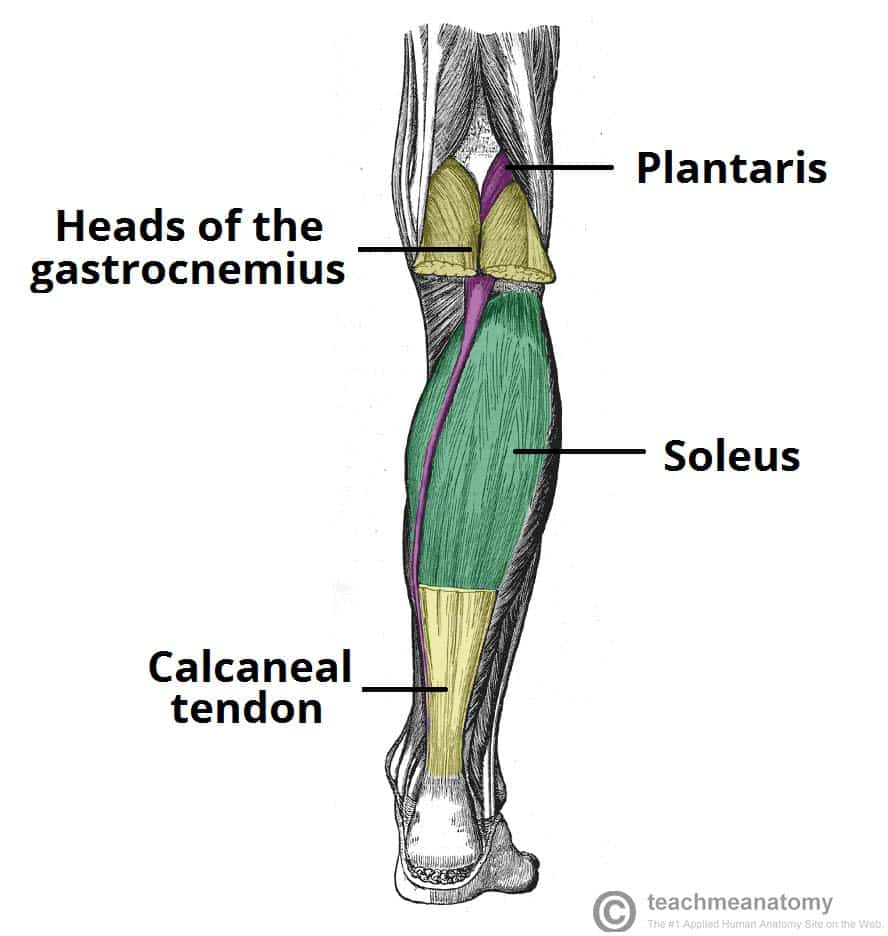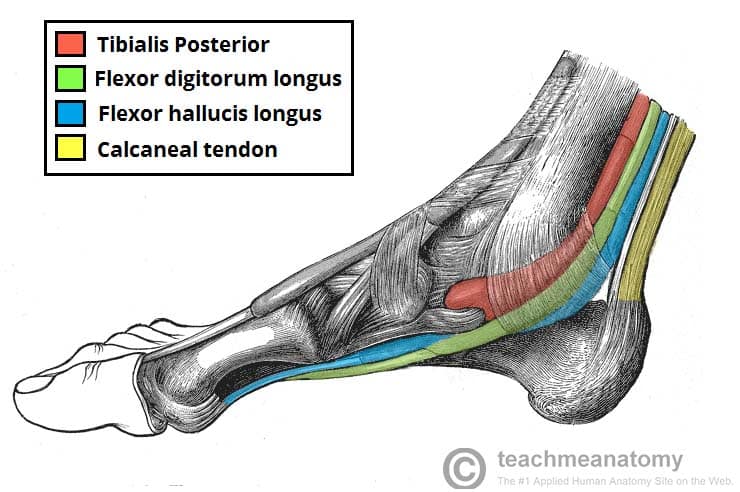The posterior compartment of the leg contains seven muscles and can be subdivided into superficial and deep compartments.
The muscles in this compartment act to plantarflex and invert the foot. They are innervated by the tibial nerve (a branch of the sciatic nerve). Blood supply chiefly from the posterior tibial artery.
In this article, we shall look at the anatomy of the muscles in the posterior compartment of the leg – their attachments, actions and clinical correlations.
Superficial Compartment
There are three muscles within the superficial compartment of the posterior leg. They all insert onto the calcaneus (heel bone) of the foot, via the calcaneal tendon.
To minimise friction during movement, there are two bursae (fluid filled sacs) associated with the calcaneal tendon:
- Subcutaneous calcaneal bursa – lies between the skin and the calcaneal tendon.
- Deep bursa of the calcaneal tendon – lies between the tendon and the calcaneus.
Gastrocnemius
The gastrocnemius is the most superficial of all the muscles in the posterior leg. It has medial and lateral heads and forms the characteristic “calf” shape of the leg.
- Attachments:
- The lateral head originates from the lateral femoral condyle. The medial head originates from the medial femoral condyle.
- The two heads combine to form a single muscle belly.
- Distally, the muscle belly converges with the soleus muscle to form the calcaneal tendon. This inserts onto the calcaneus.
- Actions: Plantarflexion at the ankle joint and flexion at the knee joint.
- Innervation: Tibial nerve.
Soleus
The soleus is a flat muscle located underneath the gastrocnemius. It gets its name from its resemblance to a sole – a flat fish.
- Attachments: Originates from the soleal line of the tibia and proximal fibula. The muscle converges with the fibres of the gastrocnemius to form the calcaneal tendon, which inserts onto the calcaneus.
- Actions: Plantarflexion of the foot at the ankle joint.
- Innervation: Tibial nerve
Plantaris
The plantaris is a small muscle which is absent in approximately 10% of the population.
- Attachments: Originates from the lateral supracondylar line of the femur. The fibres condense into a tendon which travels down the leg, between the gastrocnemius and soleus muscles. It blends with the calcaneal tendon and inserts onto the calcaneus.
- Actions: Contributes to plantarflexion at the ankle joint and flexion at the knee joint.
- Innervation: Tibial nerve.

Fig 1 – The muscles in the superficial layer of the posterior leg. The body of the gastrocnemius has been cut away to expose the underlying musculature.
Clinical Relevance: Ruptured Calcaneal Tendon
Rupture of the calcaneal tendon refers to a partial or complete tear of the tendon. It is more likely to occur in people with a history of calcaneal tendinitis (chronic inflammation of the tendon).
The injury is usually sustained during forceful plantarflexion of the foot. The patient will be unable to plantarflex the foot against resistance, and the affected foot will be permanently dorsiflexed. The soleus and gastrocnemius can contract to form a lump in the calf region.
Treatment of a ruptured calcaneal tendon is usually non-surgical, except in those with active lifestyles.
Deep Muscles
There are four muscles in the deep compartment of the posterior leg. One muscle, the popliteus, acts only on the knee joint. The remaining three muscles (tibialis posterior, flexor hallucis longus and flexor digitorum longus) act on the ankle and foot.
Popliteus
The popliteus is located behind the knee joint, forming the base of the popliteal fossa.
There is a bursa (sac-like structure containing a small amount of synovial fluid) that lies between the popliteal tendon and the posterior surface of the knee joint – it is called the popliteus bursa.
- Attachments: Originates from the lateral condyle of the femur and the lateral meniscus of the knee joint. It inserts onto the proximal tibia, immediately above the origin of the soleus muscle.
- Actions: Lateral rotation of the femur relative to the tibia. This ‘unlocks’ the knee joint so that flexion can occur.
- Innervation: Tibial nerve
Flexor Digitorum Longus
The flexor digitorum longus is a thin muscle and is located medially within the posterior leg.
- Attachments: Originates from the medial surface of the tibia and attaches to the plantar surfaces of the lateral four digits.
- Actions: Flexion of the lateral four toes.
- Innervation: Tibial nerve
Flexor Hallucis Longus
The flexor hallucis longus muscle is located laterally within the posterior compartment (this is slightly counter-intuitive, as it is the opposite side to the great toe).
- Attachments: Originates from the posterior surface of the fibula and attaches to the plantar surface of the phalanx of the great toe.
- Actions: Flexion of the great toe.
- Innervation: Tibial nerve
Tibialis Posterior
The tibialis posterior is the deepest out of the four muscles. It lies between the flexor digitorum longus and the flexor hallucis longus.
- Attachments: Originates from the posterior surface and interosseous membrane of the tibia and fibula. The tendon enters the foot posterior to the medial malleolus and attaches to the plantar surfaces of the medial tarsal bones.
- Actions: Inversion and plantarflexion of the foot. It also contributes to the medial arch of the foot.
- Innervation: Tibial nerve

